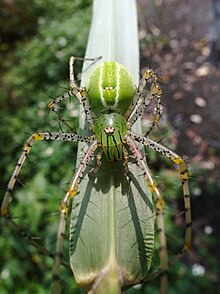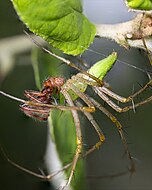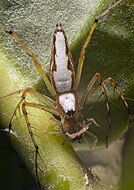| Lynx spiders Temporal range:
| |
|---|---|

| |
| Striped lynx spider (Oxyopes salticus), male | |
| Scientific classification | |
| Domain: | Eukaryota |
| Kingdom: | Animalia |
| Phylum: | Arthropoda |
| Subphylum: | Chelicerata |
| Class: | Arachnida |
| Order: | Araneae |
| Infraorder: | Araneomorphae |
| Family: | Oxyopidae Thorell, 1869 |
| Diversity | |
| 9 genera, 521 species | |

| |
Lynx spider (Oxyopidae) is a family of araneomorph spiders first described by Tamerlan Thorell in 1870.[1] Most species make little use of webs, instead spending their lives as hunting spiders on plants. Many species frequent flowers in particular, ambushing pollinators, much as crab spiders do. They tend to tolerate members of their own species more than most spiders do, and at least one species has been identified as exhibiting social behaviour.[2]
Description
[edit]There are several genera of Oxyopidae: Oxyopes, Peucetia, Hamataliwa, Hamadruas, Hostus, Pseudohostus, Schaenicoscelis, Tapinillus, and Tapponia.[3] Most spiders in the Oxyopidae family have large spiny bristles on their legs and in many species the bristles form almost a basket-like structure that may assist in confining the prey that they grasp, and protect the spider from its struggles. Most Oxyopes and Hamataliwa species are small to medium in size. Lynx spiders, in spite of being largely ambush hunters, are very speedy runners and leapers, alert and with good vision. Oxyopidae in general rely on keen eyesight in stalking, chasing, or ambushing prey, and also in avoiding enemies.
Identification
[edit]As with many other families of spiders, the arrangement of their eyes is typical of the family and is an important aid in identifying them as members of the family. Six of the eight eyes of Oxyopid spiders are arranged in a hexagon-like pattern, more or less on a prominent hump on the front upper corner of the prosoma. The other two eyes are smaller, less conspicuous, and generally are situated in front of and below the other six. The basal parts of the chelicerae of most species are large, vertical and parallel, which combine with the bluff front end, a "high forehead" to the prosoma, to give most species a peculiar "flat-faced" appearance.
Hunting
[edit]They tend to be drab ambush hunters, depending to some extent on the season, some occupy flowers, ambushing pollinating insects. In this they resemble the crab spiders (Thomisidae) in behaviour. Others crouch in wait, camouflaged on plant stalks or bark. Peucetia species on the other hand, commonly are larger. They are rangy and their camouflage is vivid green, adapted to hunting or hiding among foliage.
-
hunting spider at Mumbai @macrogiants
-
Female western lynx spider with ichneumon wasp prey.
Behavior
[edit]
Except when defending egg purses, many tend to flee rapidly when approached by predators or large creatures such as humans. They tend not to be very aggressive towards other members of their own species, and sometimes meet casually in small groups. Possibly as an extreme example, at least one member of the genus Tapinillus is remarkable as being one of the few social spiders, living in colonies with communal feeding, cooperative brood care, and generational overlap.[4] Peucetia viridans is unusual among spiders in that females defending their egg purses will spray or "spit" venom at intruders, including humans.[5]
Benefits
[edit]Some members of the genus Oxyopes are abundant enough to be important in agricultural systems as biological control agents. This is especially true of the striped lynx spider (Oxyopes salticus). Their net value in agriculture has been disputed however, on the grounds of their predation of pollinators.[6]
Genera
[edit]Genera common in the United States include common lynx spiders and green lynx spiders. As of April 2019[update], the World Spider Catalog accepts the following genera:[7]
- Hamadruas Deeleman-Reinhold, 2009 — Asia
- Hamataliwa Keyserling, 1887 — South America, North America, Central America, Asia, Australia, Africa, Caribbean
- Hostus Simon, 1898 — Madagascar
- Oxyopes Latreille, 1804 — Africa, North America, South America, Oceania, Asia, Central America, Caribbean, Italy
- Peucetia Thorell, 1869 — Asia, Australia, Europe, South America, Africa, United States, Panama
- Pseudohostus Rainbow, 1915 — Australia
- Schaenicoscelis Simon, 1898 — Brazil, Guyana
- Tapinillus Simon, 1898 — Brazil
- Tapponia Simon, 1885 — Malaysia, Indonesia
Gallery
[edit]-
Oxyopes quadrifasciatus are member of the family Oxyopidae. Photo taken in Dahod.
-
Lynx spider, Dahod
-
Oxyopes sp.
-
Lynx spider preying on a housefly
-
Male Oxyopes salticus, 4 mm. North Carolina.
-
The lynx spider, Oxyopes species with prey at Dehra Dun, India
-
Oxyopes scalaris, Western Lynx Spider
-
Lynx Spider - Wichita, Kansas, USA
-
Male and female western lynx spiders. Female (6.5 millimeter body length) on leaf. Male on clover and approached by a Halictid bee. This species is in the lynx spider family
-
Western lynx spider jumping. At least one jump was triggered by a fast flying insect approaching. Jumps are replayed in slow motion, This species is in the lynx spider family
See also
[edit]References
[edit]- ^ Thorell, T. (1870). "On European spiders". Nova Acta Regiae Societatis Scientiarum Upsaliensis. 3 (7): 109–242.
- ^ Leticia Aviles (1994). "Social behaviour in a web-building lynx spider, Tapinillus sp. (Araneae: Oxyopidae)" (PDF). Biological Journal of the Linnean Society. 51 (2): 163–176. Bibcode:1994BJLS...52..163A. doi:10.1006/bijl.1994.1045. Retrieved 2022-03-23.
- ^ "Family: Oxyopidae Thorell, 1869". World Spider Catalog. Retrieved 13 August 2024.
- ^ Aviles, Leticia : Social behaviour in a web-building lynx spider, Tapinillus spp. (Araneae, Oxyopidae) (1994) Biological Journal of the Linnean Society, 52 (2), pp. 163-176.
- ^ Fink LS. 1984. Venom spitting by the green lynx spider, Peucetia viridans (Araneae, Oxyopidae). Journal of Arachnology, vol. 12, pp. 373-4
- ^ Weems, H. V. Jr.; Whitcomb, W. H. (2001). "Green Lynx Spider, Peucetia viridans (Hentz) (Arachnida: Araneae: Oxyopidae)". Entomology and Nematology Department, Florida Cooperative Extension Service, Institute of Food and Agricultural Sciences, University of Florida. Retrieved 2022-03-23.
- ^ "Family: Oxyopidae Thorell, 1870". World Spider Catalog. Natural History Museum Bern. Retrieved 2019-04-22.














